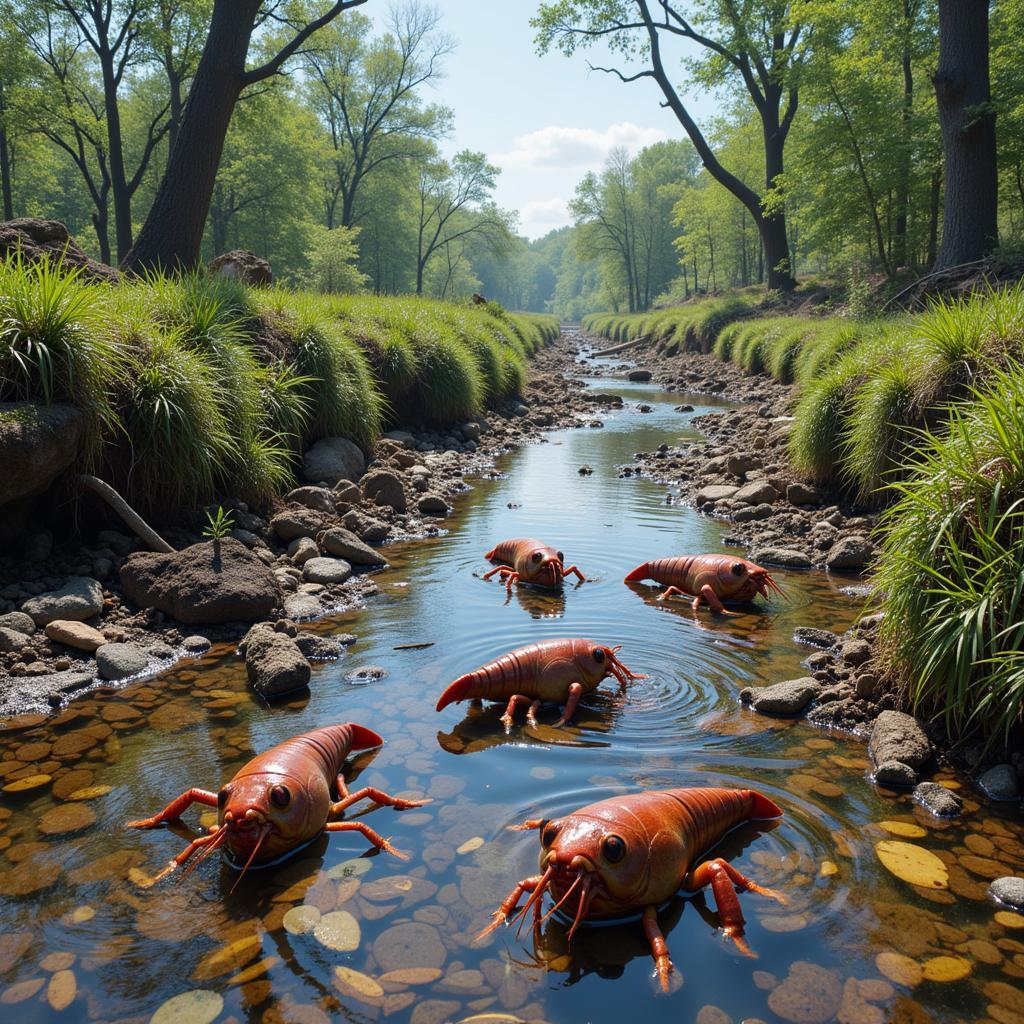Crawfish Society, often overlooked, reveals fascinating insights into social structures and behaviors within the animal kingdom. These crustaceans, found in freshwater habitats around the world, exhibit complex interactions that go beyond simple survival instincts. From their hierarchical systems to cooperative hunting strategies, crawfish societies offer a unique lens through which we can explore the dynamics of social life.
Hierarchy and Dominance in Crawfish Society
Crawfish, like many social animals, establish hierarchical structures within their communities. This social order, often based on size and strength, dictates access to resources like food, mates, and shelter. Larger, more dominant crawfish typically occupy the most desirable territories and have priority access to food. This hierarchy minimizes conflict within the group, ensuring the strongest individuals have the best chance of survival and reproduction. Smaller, subordinate crawfish must adapt by scavenging for leftover food or occupying less desirable territories. This dynamic creates a balance within the crawfish society, promoting stability and resource management.
The establishment of dominance often involves aggressive interactions, such as claw-locking and pushing contests. These ritualized displays of strength determine the social ranking within the group. Once the hierarchy is established, it reduces the need for constant fighting, contributing to the overall stability of the crawfish society.
Cooperation and Communication within Crawfish Societies
While competition plays a role in crawfish society, cooperation is equally important. Crawfish engage in cooperative behaviors, particularly when it comes to hunting and defense. They may work together to corner prey or defend their territory against intruders. This collective action increases their chances of success and survival. Crawfish communicate primarily through chemical signals, releasing pheromones into the water to convey information about their social status, reproductive readiness, and potential threats. This sophisticated communication system allows them to coordinate their actions and maintain social cohesion.
For instance, when a predator approaches, a crawfish might release an alarm pheromone that alerts other members of the group to the danger. This allows them to take evasive action, such as retreating to burrows or seeking shelter under rocks. This cooperative defense mechanism enhances the survival chances of the entire group.
The Impact of Environmental Factors on Crawfish Society
Environmental factors, such as habitat availability, food resources, and water quality, significantly influence the structure and dynamics of crawfish society. In resource-rich environments, crawfish populations may be denser, leading to increased competition and more complex social hierarchies. Conversely, in resource-scarce environments, cooperation may be more prevalent as crawfish work together to secure limited resources. Changes in water quality can also affect crawfish behavior and social interactions, potentially disrupting established hierarchies and communication systems. Understanding the interplay between environmental factors and crawfish society is crucial for conservation efforts.
Dr. Maria Sanchez, a leading expert in crustacean behavior, explains, “Crawfish societies are incredibly adaptable. They are able to adjust their social structures and behaviors in response to changes in their environment. This flexibility is key to their survival.”
Crawfish Societies and Human Interaction
Human activities, such as habitat destruction, pollution, and overfishing, can have detrimental effects on crawfish societies. These activities can disrupt established social structures, reduce population sizes, and alter the balance of the ecosystem. Understanding the complex dynamics of crawfish society is essential for developing sustainable management practices that protect these fascinating creatures and their vital role in freshwater ecosystems.
 Crawfish Habitat Destruction
Crawfish Habitat Destruction
Conclusion
Crawfish society, with its intricate hierarchies, cooperative behaviors, and sophisticated communication systems, offers a compelling look into the world of social animals. By understanding the complex dynamics within these communities, we can gain valuable insights into the broader principles of social organization and the importance of maintaining healthy ecosystems. Protecting crawfish and their habitats is essential for preserving the biodiversity of our freshwater environments. Let’s work together to ensure the future of crawfish society.
FAQ
- What is the typical social structure of a crawfish society? Crawfish typically form hierarchical structures based on size and strength, with dominant individuals having access to the best resources.
- How do crawfish communicate with each other? Crawfish communicate mainly through chemical signals called pheromones.
- What are some examples of cooperative behavior in crawfish? Crawfish cooperate in hunting and defense.
- How do environmental factors influence crawfish society? Resource availability and water quality significantly impact crawfish social structures and behaviors.
- How do human activities affect crawfish societies? Habitat destruction, pollution, and overfishing can disrupt crawfish societies and reduce their populations.
Related Questions You Might Be Interested In
- What are the different species of crawfish found around the world?
- What is the role of crawfish in the food chain?
- How can we contribute to crawfish conservation efforts?
For further assistance, please contact us at Phone Number: 02043854663, Email: [email protected], or visit us at Zone 34, Bac Giang, 260000, Vietnam. Our customer service team is available 24/7.